Xiaorui Wang
Learning and Current Prediction of PMSM Drive via Differential Neural Networks
Dec 12, 2024Abstract:Learning models for dynamical systems in continuous time is significant for understanding complex phenomena and making accurate predictions. This study presents a novel approach utilizing differential neural networks (DNNs) to model nonlinear systems, specifically permanent magnet synchronous motors (PMSMs), and to predict their current trajectories. The efficacy of our approach is validated through experiments conducted under various load disturbances and no-load conditions. The results demonstrate that our method effectively and accurately reconstructs the original systems, showcasing strong short-term and long-term prediction capabilities and robustness. This study provides valuable insights into learning the inherent dynamics of complex dynamical data and holds potential for further applications in fields such as weather forecasting, robotics, and collective behavior analysis.
A Graph-Based Synthetic Data Pipeline for Scaling High-Quality Reasoning Instructions
Dec 12, 2024Abstract:Synthesizing high-quality reasoning data for continual training has been proven to be effective in enhancing the performance of Large Language Models (LLMs). However, previous synthetic approaches struggle to easily scale up data and incur high costs in the pursuit of high quality. In this paper, we propose the Graph-based Synthetic Data Pipeline (GSDP), an economical and scalable framework for high-quality reasoning data synthesis. Inspired by knowledge graphs, we extracted knowledge points from seed data and constructed a knowledge point relationships graph to explore their interconnections. By exploring the implicit relationships among knowledge, our method achieves $\times$255 data expansion. Furthermore, GSDP led by open-source models, achieves synthesis quality comparable to GPT-4-0613 while maintaining $\times$100 lower costs. To tackle the most challenging mathematical reasoning task, we present the GSDP-MATH dataset comprising over 1.91 million pairs of math problems and answers. After fine-tuning on GSDP-MATH, GSDP-7B based on Mistral-7B achieves 37.7% accuracy on MATH and 78.4% on GSM8K, demonstrating the effectiveness of our method. The dataset and models trained in this paper will be available.
Adaptive Integral Sliding Mode Control for Attitude Tracking of Underwater Robots With Large Range Pitch Variations in Confined Space
May 01, 2024Abstract:Underwater robots play a crucial role in exploring aquatic environments. The ability to flexibly adjust their attitudes is essential for underwater robots to effectively accomplish tasks in confined space. However, the highly coupled six degrees of freedom dynamics resulting from attitude changes and the complex turbulence within limited spatial areas present significant challenges. To address the problem of attitude control of underwater robots, this letter investigates large-range pitch angle tracking during station holding as well as simultaneous roll and yaw angle control to enable versatile attitude adjustments. Based on dynamic modeling, this letter proposes an adaptive integral sliding mode controller (AISMC) that integrates an integral module into traditional sliding mode control (SMC) and adaptively adjusts the switching gain for improved tracking accuracy, reduced chattering, and enhanced robustness. The stability of the closed-loop control system is established through Lyapunov analysis. Extensive experiments and comparison studies are conducted using a commercial remotely operated vehicle (ROV), the results of which demonstrate that AISMC achieves satisfactory performance in attitude tracking control in confined space with unknown disturbances, significantly outperforming both PID and SMC.
Jointly Recognizing Speech and Singing Voices Based on Multi-Task Audio Source Separation
Apr 17, 2024Abstract:In short video and live broadcasts, speech, singing voice, and background music often overlap and obscure each other. This complexity creates difficulties in structuring and recognizing the audio content, which may impair subsequent ASR and music understanding applications. This paper proposes a multi-task audio source separation (MTASS) based ASR model called JRSV, which Jointly Recognizes Speech and singing Voices. Specifically, the MTASS module separates the mixed audio into distinct speech and singing voice tracks while removing background music. The CTC/attention hybrid recognition module recognizes both tracks. Online distillation is proposed to improve the robustness of recognition further. To evaluate the proposed methods, a benchmark dataset is constructed and released. Experimental results demonstrate that JRSV can significantly improve recognition accuracy on each track of the mixed audio.
Filter Pruning via Filters Similarity in Consecutive Layers
Apr 26, 2023Abstract:Filter pruning is widely adopted to compress and accelerate the Convolutional Neural Networks (CNNs), but most previous works ignore the relationship between filters and channels in different layers. Processing each layer independently fails to utilize the collaborative relationship across layers. In this paper, we intuitively propose a novel pruning method by explicitly leveraging the Filters Similarity in Consecutive Layers (FSCL). FSCL compresses models by pruning filters whose corresponding features are more worthless in the model. The extensive experiments demonstrate the effectiveness of FSCL, and it yields remarkable improvement over state-of-the-art on accuracy, FLOPs and parameter reduction on several benchmark models and datasets.
Improving Prosody for Cross-Speaker Style Transfer by Semi-Supervised Style Extractor and Hierarchical Modeling in Speech Synthesis
Mar 14, 2023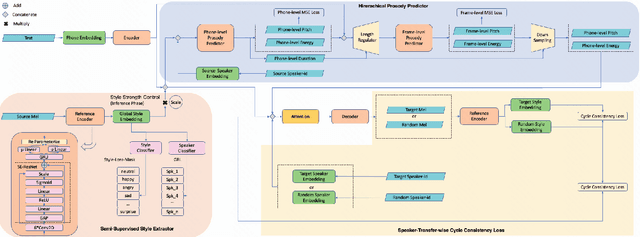
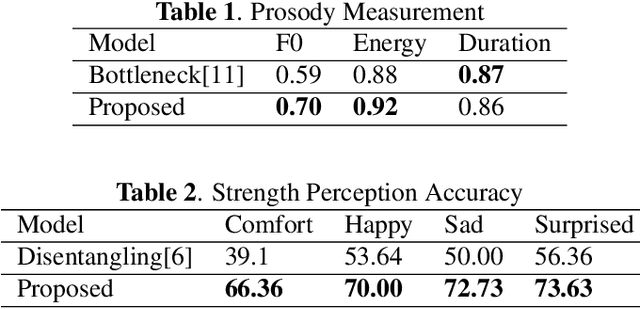

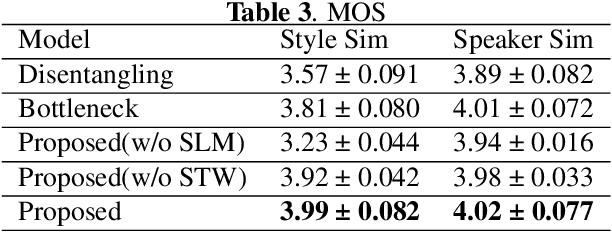
Abstract:Cross-speaker style transfer in speech synthesis aims at transferring a style from source speaker to synthesized speech of a target speaker's timbre. In most previous methods, the synthesized fine-grained prosody features often represent the source speaker's average style, similar to the one-to-many problem(i.e., multiple prosody variations correspond to the same text). In response to this problem, a strength-controlled semi-supervised style extractor is proposed to disentangle the style from content and timbre, improving the representation and interpretability of the global style embedding, which can alleviate the one-to-many mapping and data imbalance problems in prosody prediction. A hierarchical prosody predictor is proposed to improve prosody modeling. We find that better style transfer can be achieved by using the source speaker's prosody features that are easily predicted. Additionally, a speaker-transfer-wise cycle consistency loss is proposed to assist the model in learning unseen style-timbre combinations during the training phase. Experimental results show that the method outperforms the baseline. We provide a website with audio samples.
Style-Label-Free: Cross-Speaker Style Transfer by Quantized VAE and Speaker-wise Normalization in Speech Synthesis
Dec 13, 2022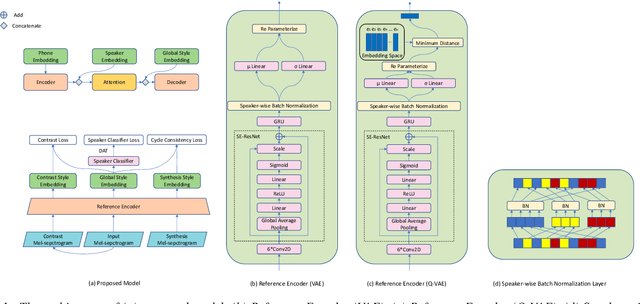


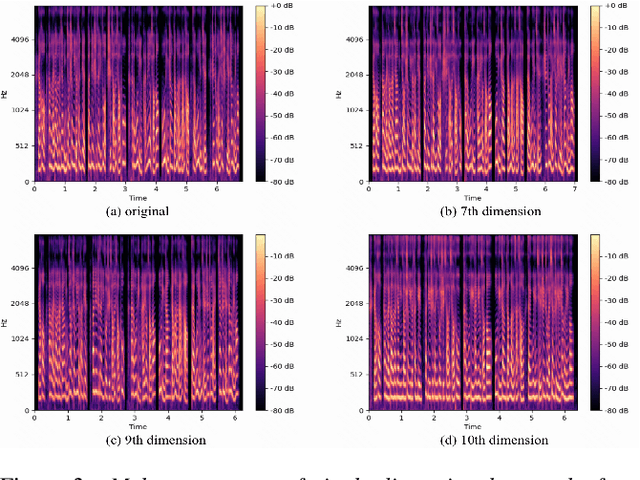
Abstract:Cross-speaker style transfer in speech synthesis aims at transferring a style from source speaker to synthesised speech of a target speaker's timbre. Most previous approaches rely on data with style labels, but manually-annotated labels are expensive and not always reliable. In response to this problem, we propose Style-Label-Free, a cross-speaker style transfer method, which can realize the style transfer from source speaker to target speaker without style labels. Firstly, a reference encoder structure based on quantized variational autoencoder (Q-VAE) and style bottleneck is designed to extract discrete style representations. Secondly, a speaker-wise batch normalization layer is proposed to reduce the source speaker leakage. In order to improve the style extraction ability of the reference encoder, a style invariant and contrastive data augmentation method is proposed. Experimental results show that the method outperforms the baseline. We provide a website with audio samples.
Back-Translation-Style Data Augmentation for Mandarin Chinese Polyphone Disambiguation
Nov 17, 2022Abstract:Conversion of Chinese Grapheme-to-Phoneme (G2P) plays an important role in Mandarin Chinese Text-To-Speech (TTS) systems, where one of the biggest challenges is the task of polyphone disambiguation. Most of the previous polyphone disambiguation models are trained on manually annotated datasets, and publicly available datasets for polyphone disambiguation are scarce. In this paper we propose a simple back-translation-style data augmentation method for mandarin Chinese polyphone disambiguation, utilizing a large amount of unlabeled text data. Inspired by the back-translation technique proposed in the field of machine translation, we build a Grapheme-to-Phoneme (G2P) model to predict the pronunciation of polyphonic character, and a Phoneme-to-Grapheme (P2G) model to predict pronunciation into text. Meanwhile, a window-based matching strategy and a multi-model scoring strategy are proposed to judge the correctness of the pseudo-label. We design a data balance strategy to improve the accuracy of some typical polyphonic characters in the training set with imbalanced distribution or data scarcity. The experimental result shows the effectiveness of the proposed back-translation-style data augmentation method.
Parameter-Efficient Conformers via Sharing Sparsely-Gated Experts for End-to-End Speech Recognition
Sep 17, 2022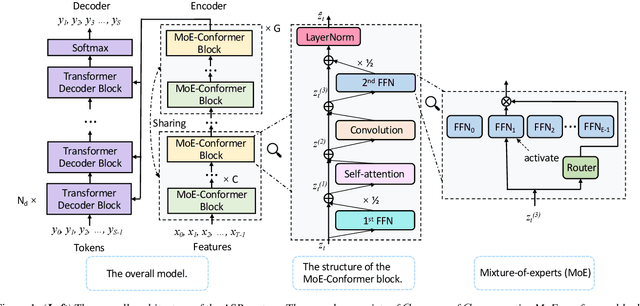


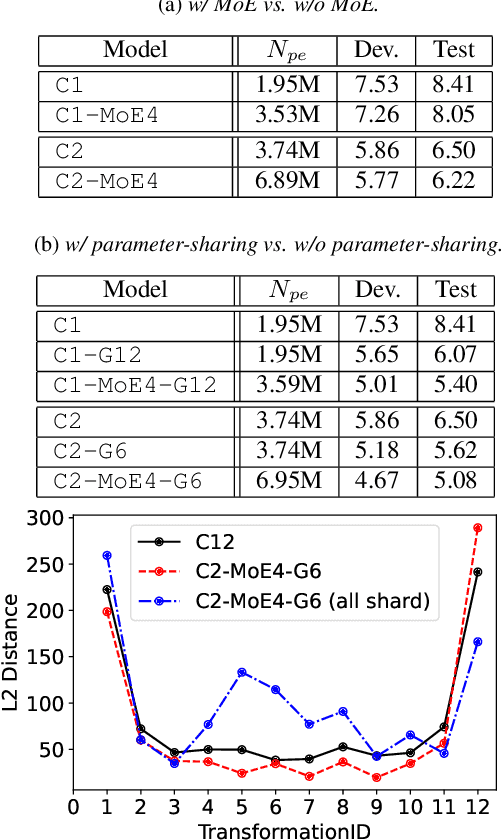
Abstract:While transformers and their variant conformers show promising performance in speech recognition, the parameterized property leads to much memory cost during training and inference. Some works use cross-layer weight-sharing to reduce the parameters of the model. However, the inevitable loss of capacity harms the model performance. To address this issue, this paper proposes a parameter-efficient conformer via sharing sparsely-gated experts. Specifically, we use sparsely-gated mixture-of-experts (MoE) to extend the capacity of a conformer block without increasing computation. Then, the parameters of the grouped conformer blocks are shared so that the number of parameters is reduced. Next, to ensure the shared blocks with the flexibility of adapting representations at different levels, we design the MoE routers and normalization individually. Moreover, we use knowledge distillation to further improve the performance. Experimental results show that the proposed model achieves competitive performance with 1/3 of the parameters of the encoder, compared with the full-parameter model.
MELONS: generating melody with long-term structure using transformers and structure graph
Nov 03, 2021

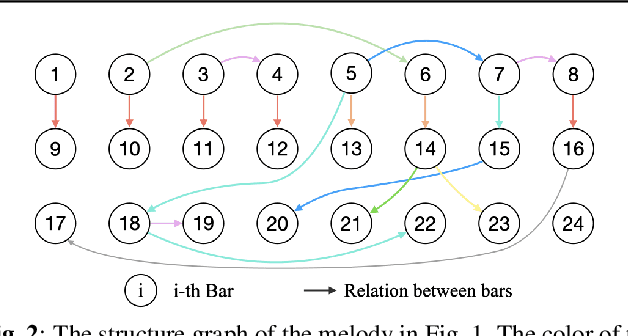
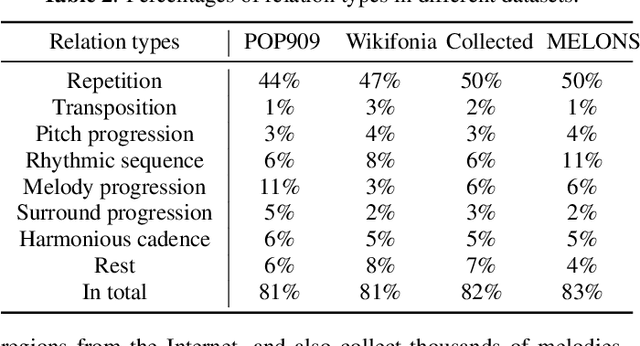
Abstract:The creation of long melody sequences requires effective expression of coherent musical structure. However, there is no clear representation of musical structure. Recent works on music generation have suggested various approaches to deal with the structural information of music, but generating a full-song melody with clear long-term structure remains a challenge. In this paper, we propose MELONS, a melody generation framework based on a graph representation of music structure which consists of eight types of bar-level relations. MELONS adopts a multi-step generation method with transformer-based networks by factoring melody generation into two sub-problems: structure generation and structure conditional melody generation. Experimental results show that MELONS can produce structured melodies with high quality and rich contents.
 Add to Chrome
Add to Chrome Add to Firefox
Add to Firefox Add to Edge
Add to Edge